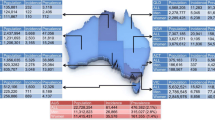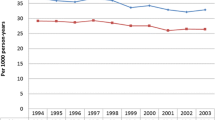Abstract
Heart failure disproportionately affects the older population. Approximately 80% of all cases of heart failure in the United States occur in persons aged 65 years and older. It is associated with very poor long-term survival, with a minority surviving 5 years after diagnosis. In the older population, heart failure accounts for more hospital admissions than any other single condition. Following hospitalization for heart failure, older persons are at high risk for re-hospitalization: nearly half are readmitted within 6 months. The economic impact of the condition is thus dramatic. Despite the importance of heart failure in the older population, there is a dearth of research specifically targeting this group. This review highlights the importance of heart failure in the older population and identifies the specific areas where research and policy initiatives may be instrumental in reducing the impact of the condition.
Similar content being viewed by others
References
Schocken DD, Arrieta MI, Leaverton PE, Ross EA. Prevalence and mortality rate of congestive heart failure in the United States. J Am Coll Cardiol 1992;20:301-306.
McKee PA, Castelli WP, McNamara PM, Kannel WB. The natural history of congestive heart failure: the Framingham study. N Engl J Med 1971;285:1441- 1446.
Kannel WB, Ho K, Thom T. Changing epidemiological features of cardiac failure. Br Heart J 1994;72:S3-S9.
Ho KK, Pinsky JL, Kannel WB, Levy D. The epidemiology of heart failure: the Framingham study. J Am Coll Cardiol 1993;22:6A-13A.
Senni M, Tribouilloy CM, Rodeheffer RJ, Jacobsen SJ, Evans JM, Bailey KR, et al. Congestive heart failure in the community: a study of all incident cases in Olmsted County, Minnesota, in 1991. Circulation 1998;98:2282-2289.
Gottdiener JS, Arnold AM, Aurigemma GP, Polak JF, Tracy RP, Kitzman DW, et al. Predictors of congestive heart failure in the elderly: the Cardiovascular Health Study. J Am Coll Cardiol 2000;35:1628–1637.
Ghali JK, Cooper R, Ford E. Trends in hospitalization rates for heart failure in the United States, 1973-1986. Evidence for increasing population prevalence. Arch Intern Med 1990;150:769–773.
National Center for Health Statistics HCSB. 1987 Summary: National Hospital Discharge Survey: Advance Data from Vital and Health Statistics No. 159. Hyattsville, MD: US Public Health Service, 2000.
Foot DK, Lewis RP, Pearson TA, Beller GA. Demographics and cardiology, 1950-2050. J Am Coll Cardiol 2000;35:66B-80B.
Vasan RS, Larson MG, Benjamin EJ, Evans JC, Reiss CK, Levy D. Congestive heart failure in subjects with normal versus reduced left ventricular ejection fraction: prevalence and mortality in a population-based cohort. J Am Coll Cardiol 1999;33:1948-1955.
Kitzman D, Gardin JM, Arnold A, Gottdiener JS, Lyles M, Smith VE, et al. Heart failure with preserved systolic LV function in the elderly: clinical and echocardiographic correlates from the Cardiovascular Health Study. Circulation 1996;94:I–433.
Krumholz HM, Chen YT, Wang Y, Radford MJ, Vaccarino V. Prognostic importance of normal left ventricular ejection fraction in elderly patients hospitalized with congestive heart failure. Circulation 1997;96:I–504.
Lindenfeld J, Fiske KS, DeBuhr J, Stevens ER, Havranek EP, Abrams FR. Heart failure is due to diastolic dysfunction in women more often than in men. J Am Coll Cardiol 1999;33:180A-181A.
Ghali JK, Kadakia S, Bhatt A, Cooper R, Liao Y. Survival of heart failure patients with preserved versus impaired systolic function: the prognostic implication of blood pressure. Am Heart J 1992;123:993-997.
Judge KW, Pawitan Y, Caldwell J, Gersh BJ, Kennedy JW. Congestive heart failure symptoms in patients with preserved left ventricular systolic function: analysis of the CASS registry. J Am Coll Cardiol 1991;18:377-382.
Dauterman KW, Rowell RA, Massie BM. CHF with preserved systolic function; mortality, readmission rate, and ACE-inhibitor effect in a statewide sample of community hospitals. Circulation 1997;96:I–391.
McDermott MM, Feinglass J, Lee P, Mehta S, Lefebre F, Schmidt B. Preserved left ventricular systolic function versus systolic dysfunction in congestive heart failure: a comparison of clinical characteristics, hospital readmission rates, and survival. J Invest Med 1996;44:363A.
Ho KK, Anderson KM, Kannel WB, Grossman W, Levy D. Survival after the onset of congestive heart failure in Framingham Heart Study subjects. Circulation 1993;88:107-115.
Croft JB, Giles WH, Pollard RA, Keenan NL, Casper ML, Anda RF. Heart failure survival among older adults in the United States: a poor prognosis for an emerging epidemic in the Medicare population. Arch Intern Med 1999;159:505-510.
Senni M, Tribouilloy CM, Rodeheffer RJ, Jacobsen SJ, Evans JM, Bailey KR, et al. Congestive heart failure in the community: trends in incidence and survival in a 10-year period. Arch Intern Med 1999;159:29-34.
Changes in mortality from heart failure-United States, 1980-1995. MMWR 1998;47:633-637.
Dicker RC, Han LF, Mancone JJ. Quality of care surveillance using administrative data, 1996. Quality resume, no. 2. 1998. Health Care Financing Administration.
Wolf LF. Health Care Financing Review: Medicare and Medicaid Statistical Supplement. Baltimore: Health Care Financing Administration, Office of Strategic Planning, 1998.
Krumholz HM, Parent EM, Tu N, Vaccarino V, Wang Y, Radford MJ, et al. Readmission after hospitalization for congestive heart failure among Medicare beneficiaries. Arch Intern Med 1997;157:99-104.
Krumholz HM, Chen YT, Wang Y, Vaccarino V, Radford MJ, Horwitz RI. Predictors of readmission among elderly survivors of admission with heart failure. Am Heart J 2000;139:72-77.
Ware JE. SF-36 Physical and Mental Health Summary Scales: a User's Manual. Boston: The Health Institute, New England Medical Center, 1994.
Rector TS, Kubo SH, Cohn JN. Patients' self-assessment of their congestive heart failure: Content, reliability, and validity of a new measure - the Minnesota Living with Heart Failure questionnaire. Heart Failure 1987;3:189-209.
Green CP, Porter CB, Bresnahan DR, Spertus JA. Development and evaluation of the Kansas City Cardiomyopathy Questionnaire: a new health status measure for heart failure. J Am Coll Cardiol 2000;35:1245-1255.
Chin MH, Goldman L. Gender differences in 1-year survival and quality of life among patients admitted with congestive heart failure. Med Care 1998;36:1033-1046.
Stadnyk K, Calder J, Rockwood K. Testing the measurement properties of the Short Form-36 Health Survey in a frail elderly population. J Clin Epidemiol 1998;5:827-835.
O'Connell JB, Bristow MR. Economic impact of heart failure in the United States: time for a different approach. J Heart Lung Transplant 1994;13:S107- S112.
Medicare Payment Advisory Commission. Report to Congress: Context for a Changing Medicare Program. Washington, DC, 1998.
Havranek EP, Abraham WT. The health-care economics of heart failure. Heart Failure 1998;14:10-18.
The Large State Peer Review Organization Consortium. Heart failure treatment with angiotensinconverting enzyme inhibitors in hospitalized Medicare patients in 10 large states. Arch Intern Med 1997;157:1103-1108.
Philbin EF. Comprehensive multidisciplinary programs for the management of patients with congestive heart failure. J Gen Intern Med 1999;14:130-135.
Author information
Authors and Affiliations
Rights and permissions
About this article
Cite this article
Masoudi, F.A., Havranek, E.P. & Krumholz, H.M. The Burden of Chronic Congestive Heart Failure in Older Persons: Magnitude and Implications for Policy and Research. Heart Fail Rev 7, 9–16 (2002). https://doi.org/10.1023/A:1013793621248
Issue Date:
DOI: https://doi.org/10.1023/A:1013793621248




